Daguerreotype and Early American Photography Flashcards
1/23
There's no tags or description
Looks like no tags are added yet.
Name | Mastery | Learn | Test | Matching | Spaced |
|---|
No study sessions yet.
24 Terms
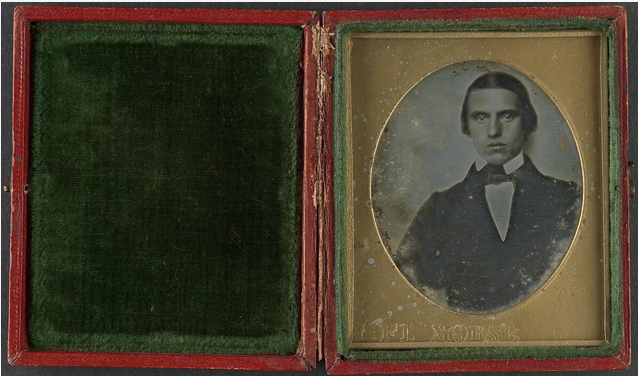
Portrait of a Young Man
Samuel F.B. Morse, 1840, Daguerreotype
Morse met Daguerre in 1839, and was the first American to see a Daguerreotype and experiment with the medium
The sitter is unknown, but his expression shows the struggle to keep his eyes open for the 20-30 minute exposure, and one that reflects the excitement of early photography

Blind Man and His Reader
Unknown, 1850, Daguerreotype
Not much is known about this one, except the reader is holding a copy of the New York Herald, a newspaper
The Herald was known for its interest in scandal and crime, and was at one point the largest circulating daily in the US
What was in the news the day this photograph was made?
perhaps an article about newly invented Moon Type, a raised type like Braille, but pre-dated it by more than 20 years
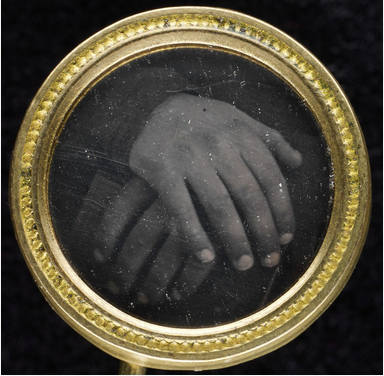
Button
Unknown, 1840-50s, Daguerreotype
A picture of two hands resting on a book on a sewing button, one that was mass produced from 1830-50
Reflective of the political buttons of the time, that began in around the 1700s
such as buttons that proclaimed ‘Independence’ (of the goal of the colonists) and ‘Long Live the President’ in honor of Washington
However, it wasn’t until 1828 that it became common usage in elections
This image was believed to represent an anti-slavery motif, one white hand and one black hand resting on a bible
later, after a digital re-imaging, it seems to show that the hands both belong to one individual
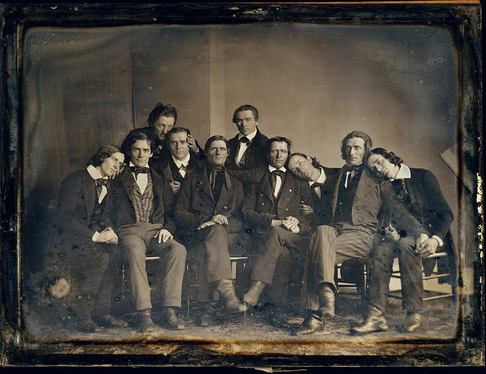
Hutchinson Family Singers
Unknown, 1845, Daguerreotype
The singers were thirteen of the sixteen children of the Hutchinson family of New Hampshire, and debuted in 1830, singing patriotic tunes celebrating rural life
however, they would later join political movements such as temperance, women’s rights, and the abolition of slavery
they were very controversial in the press, and became the first group of social protest folk singers, and performed for more than 50 years

Tom Thumb (Charles Sherwood Stratton)
Unknown, General Tom Thumb, 1848, Daguerreotype
No description, but Tom Thumb is a character from English folklore, one who is hired by maidservants to frighten children inside a world with magic and mana

Lemuel Shaw
Southworth and Hawes, 1850, Daguerreotype
Southworth and Hawes primarily photographed leading political, intellectual and artistic figures
Lamuel Shaw has an imposing presence, showing his position as chief Justice of the Massachusetts Supreme Court (1830-1860)
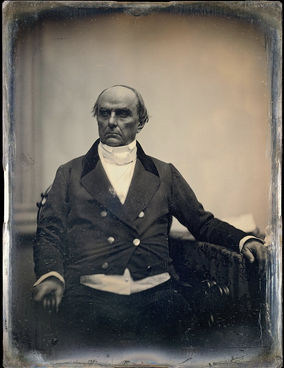
Daniel Webster
Southworth and Hawes, 1850, Daguerreotype
Webster (1782-1852) was one of America’s most imposing figures, a public speaker with staggering power
He sat for this portrait one month before his most controversial speech in support of the Compromise of 1850, of which allowed fugitive slaves to be returned to their owners
Which would later lead to his political downfall
Southworth and Hawes photograph him as a powerful figure, reflecting Carlyle’s opinion of him being a powerful lecturer

Rufus Chaote
Southworth and Hawes, 1850, Daguerreotype
Choate was one of America’s most capable lawyer’s and statesment of the time
The photographers begged him to pose multiple times, until he finally accepted and posed 4 or 5 times with the appropriate props, before rushing back to his clientele
Shows him appropriately as a disheveled workaholic and frequent sufferer of headaches, but also driven by his nervous passion.
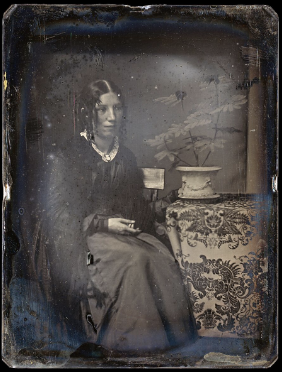
Harriet Beecher Stowe
Southworth and Hawes, 1850s, Daguerreotype
Stowe’s portrait was probably made around the time of the publication of her novel Uncle Tom’s Cabin (1852)
The highly religious Stowe proclaimed the book plot as a vision from God, and was essential in antislavery movements in the North, prior to the Civil War
The portrait shows her as small and demure, in contrast to her massive literary influence
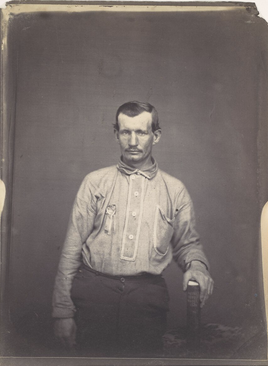
Man Holding Patent Office Book
Oliver H. Willard, 1857, Paper print
Willard was an active photograph-maker in Philadelphia, and was an obscure early practitioner of wet plate and salted paper practices
The sitter probably had this portrait made for remembrance for family members, prior to a move west, or to commemorate an award
his clothing and pose speak to the influence of the common man
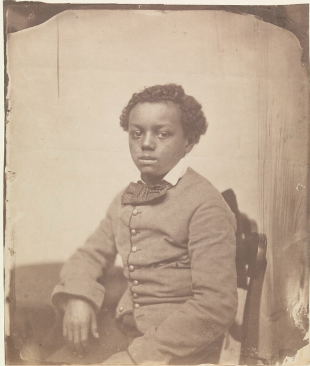
Portrait of a Youth
Unknown, 1850s-60s, Paper print
Unusual formal portrait of a young African American boy, with the composure of a prince
Boston, a spiritual center for the abolitionists, is the likely source of this print, in support of the movement
The careful composition likely shows this to be the work of a fine photographer, maybe Whipple, Black, or Southworth & Hawes

Cornelius Conway Felton with His Hat and Coat
John Adams Whipple, 1850s, Daguerreotype
A rare diptych, showing Conway, a Professor of Greek Literature at Harvard, reaching for his felt hat and duster
Conway was born in poverty, but would later become Harvard’s president in 1860, although never losing passion for the common life
The portrait pokes fun at the rigidness of professor wear, showing the flexibility of his hat, usually an outdoorsy wear, compared to the stiff hats usual professors wore at the time
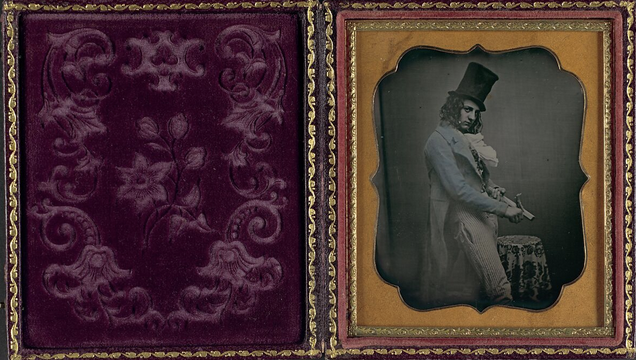
Man Whittling a Stick
Unknown, 1850s, Daguerreotype
Shows the popular stage character from American regional theater, the ‘Wily Yankee’
this stock character would become the visual prototype for ‘Uncle Sam’
The whittling relates to the character’s role, as in between acts, he would wittle on-stage, and would flirt with both women and men in the audience, suggestively carving the stick near his crotch
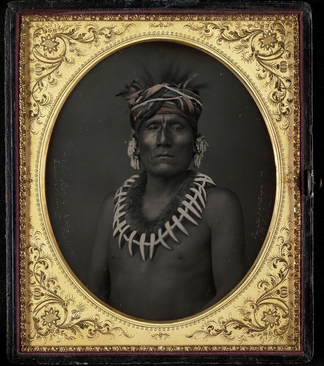
Kno-Shr, Kansas Chief
John H. Fitzgibbon, 1853, Daguerreotype
From 1840s to 1860, Fitzgibbon had one of the most prominent photo studies in Saint Louis, Missouri
best known for his scenes of regional life west of the Mississippi River
The Chief is shown bare-chested, wearing a traditional coveted grizzly bear claw necklace
several details of the photograph are hand colored with red paint, showing the color of strength and to ward off evil spirits
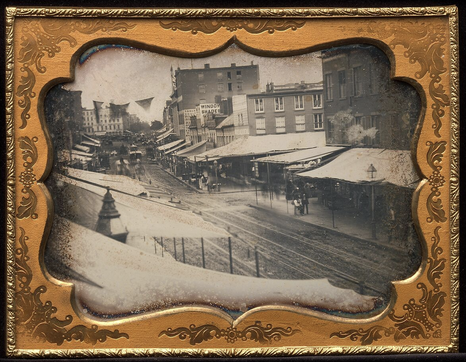
Chatham Square, New York
Unknown, 1850s, Daguerreotype
Unlike previous pretty period printed views, this Daguerreotype shows the city as busy and confusing
Shows business of stores around downtown, and showed New York’s prominence as the Great Emporium
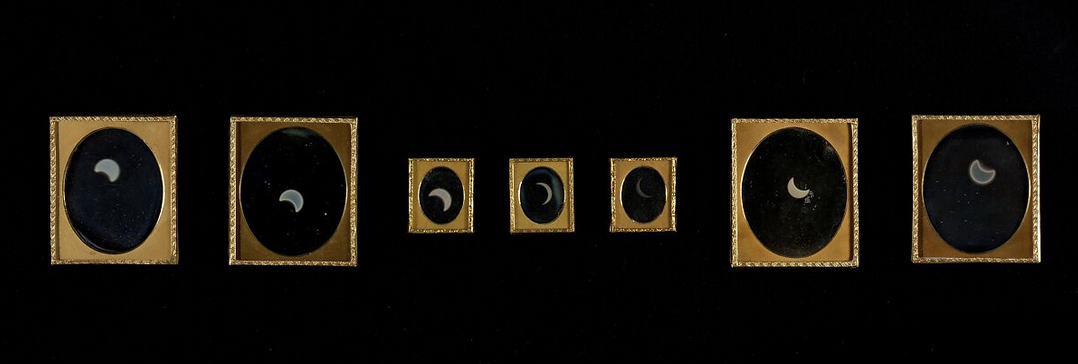
Eclipse of the Sun
W. & F. Lagenheim, 1850s, Daguerreotype
Langenheim opened their studio in the 1840s, and although they weren’t the first, they were the most celebrated
These daguerreotypes show the first eclipse since the invention of photography, and although 6 other photographers captured this event, this is the only surviving one
May seem odd however, because in the northern hemisphere the sun usuing goes from right to left during an eclipse
shows the mirroring of uncorrected Daguerreotypes
They are so small because of the technical limitations of the Daguerreotype, since there was much less light outdoors during this eclipse
there’s supposedly an 8th image, rendered in total darkness because of the eclipse
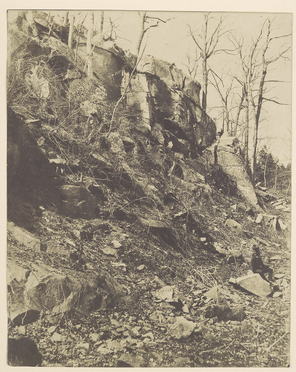
Rocky Hillside
Victor Prevost, 1850s, Paper print
Prevost emigrated to America in 1848, and was one of the most mysterious early photographers
Learned the photo print technique from Le Gray, a leading French photographer of the time, and used it to photograph New York City beginning in 1853
His photos greatly consider artistic composition, and this photograph offers a rare example of an artist of the time working just for his pleasure

Frederick Douglass
Unknown, 1855, Daguerreotype
Douglass, (1817-1895) was born into slavery, escaped in 1838, and was the most persuasive orator for abolition, and other causes
he founded a newspaper, and penned three autobiographied, and lectured extensively before and after the Civil War
He lectured in favor of photography as a medium for representing African Americans, getting rid of the distortion that came from mediums like painting
(and to reverse the “social death” caused by slavery)
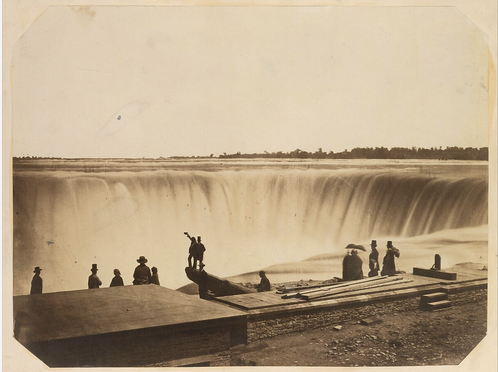
Niagara Falls
Silas A. Holmes, 1850s, Paper print
Shows the casuality of tourists at a popular landmark, probably taken by Holmes from Table Rock, on the Canadian side of the falls
Holmes was a popular NY photographer of landmarks for tourists
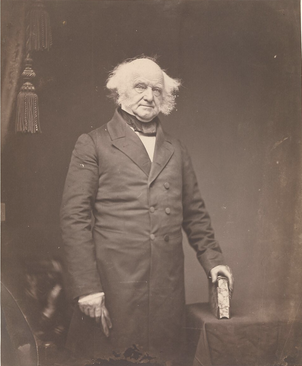
President Martin Van Buren
Mathew B. Brady, 1850s, Paper Print
Van Buren (1782-1862) was a seasoned Democratic statesman, and held position as attorney general and governer of New York, a US senator, ambassador to England, secretary of state, and vice-president under Andrew Jackson
because of his short stature and political prowess, the press dubbed him “The Little Magician”
Although he fell out of favor when he lost his bid for his party’s presidential nomination in 1840, 1844, and the Free Soilers campaign in 1848
Regardless, Brady saw Van Buren as just the right person to promote his portrait studio
The portrait hides his height, and was printed at an extremely large size, coined by Brady as an ‘imperial’ print

Two Girls in Identical Dresses
Jeremiah Gurney, 1857, Daguerreotype
Gurney, born in NY state, moved to NYC to work in the jewelry trade, but was among the earliest to learn the Daguerreotype process and opened one of the first portrait galleries on Broadway in 1840
His specialty was in three-dimensional portraits
His clientele were primarily the New York cultural elite, not the political and entertainment giants as photographed by his colleague, Brady
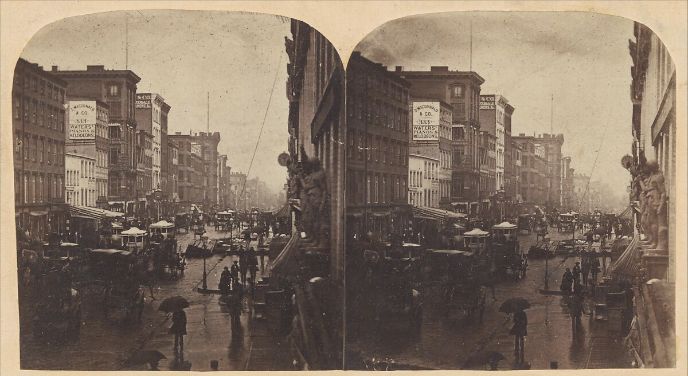
Broadway in the Rain
Edward and Henry T. Anthony, 1860s, Albumen Silver Print
likely from 308/310 Broadway, New York City
Edward and his brother Anthony were the founders of NY’s first camera and photographic supply manufacturer
in 1859, they published a series of ‘stop-action’ or instantaneous stereographic views, including this piece
The photograph sold thousands of copies in the 1860s, and is one of the most collectible images of NYC
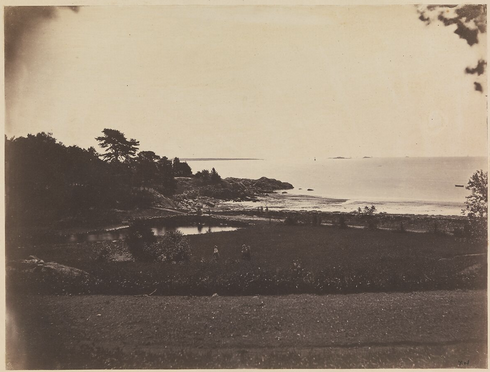
Landscape, Pride’s Crossing
Samuel Masury, 1856, Paper print
Masury learned the Daguerreotype trade in 1842 in Plumbe’s Boston gallery, and would later travel to Paris in 1855 to learn the glass negative process from the Bisson brothers
The Bissons had internationally celebrated landscape photos
Charles Greeley Loring’s summer estate in Massachusetts was the perfect place to test his new knowledge
His photos mainly focused on the foreground’s deep shadows, contrasting with the lightness of the sea and the sky
Recalls the paintings of John F. Kensett, who often sketched this estate

Boston from a Hot-Air Balloon
James Wallace Black, 1860s, Albumen silver print from glass negative
Two years after Nadar’s experimental photography in balloon flight, Black sailed over Boston to make the first successful aerial photographs in America
He flew on a balloon called the “Queen of the Air,” and produced several photographs
Almost immediately after, aerial photograph would be put to use by the Union Army
in 1862, President Lincoln created a civilian Balloon Corps to spy from the skies on Confederate troops during the Peninsular Campaign in Virginia